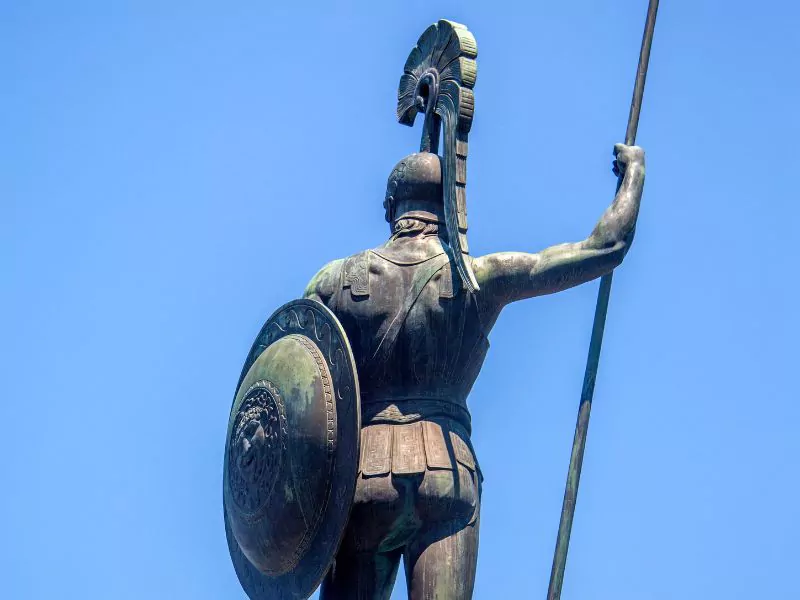The palace gardens of Achilleion Palace proudly host the impressive “Achilles Triumphant”. This monumental marble statue, crafted by the renowned artist Ferdinand von Miller, depicts the legendary Greek hero Achilles in all his glory. The sculpture captures Achilles’ strength, bravery, and valour, serving as a notable tribute to this iconic figure in Greek mythology. The meticulously detailed craftsmanship and the sheer size of the statue add to its awe-inspiring presence in the idyllic palace garden setting.
Table of Contents

The Sculptor Behind Achilles Triumphant
The “Achilles Triumphant” is a masterpiece crafted by the distinguished German sculptor, Ferdinand von Miller. Born in Munich in 1813, Miller was acclaimed for his monumental works in bronze and marble, and his creations adorn several prestigious locations across Europe. His inspiration for “Achilles Triumphant” emanated from his profound admiration for Greek mythology and the heroic narratives it encompassed.
Particularly, the character of Achilles, with his invincible prowess and tragic vulnerability, resonated deeply with Miller. This fascination, coupled with his exceptional artistic skill, led to the conception of the resplendent “Achilles Triumphant”. The statue is not merely a representation of Achilles’ physical might, but it also encapsulates the inner turmoil and indomitable spirit of this legendary Greek hero.
The Legend of the Triumph of Achilles
The Triumph of Achilles is a monumental tale in Greek Mythology, highlighting the power and tragedy of the hero’s story. Achilles, the son of mortal Peleus and the sea-nymph Thetis, was deemed invincible, save for his heel, which was his only vulnerable spot.
The legend most vividly comes alive during the Trojan War, where Achilles’ might and prowess in battle were unrivalled. His triumphs were numerous, with the most prominent being his victory over Hector, the Trojan prince and the greatest fighter for Troy. This victory cemented Achilles’ status as the greatest warrior in the Greek army.
Despite his battlefield triumphs, Achilles’ fate was sealed by his tragic vulnerability. During the final days of the Trojan War, he was fatally struck by an arrow in his heel, the only part of his body that his mother had not submerged in the River Styx to make him invulnerable.
This tale of Achilles’ triumph and tragedy has been immortalised in countless works of literature and art, including the magnificent “Achilles Triumphant” in the Achilleion Palace.

Achilles Triumphant in a nutshell
- “Achilles Triumphant” is a monumental marble statue located in the gardens of Achilleion Palace in Corfu, Greece.
- The statue is a tribute to the Greek hero Achilles, renowned for his strength, courage, and heroism.
- Crafted by acclaimed German sculptor, Ferdinand von Miller, the statue showcases meticulous detailing and impressive size.
- The sculpture not only portrays Achilles’ physical strength but also embodies his inner turmoil and indomitable spirit.
- The tale of Achilles’ triumph and subsequent tragedy during the Trojan War serves as the influential narrative behind this statue.
- Positioned against the backdrop of the scenic Ionian Sea, the statue adds to the grandeur and allure of the Achilleion Palace.

Further Research
For those interested in exploring more about the life and legend of the Greek hero Achilles, the following resources provide detailed insights:
- The Iliad by Homer: This epic Greek poem forms the core of the Western canon and is considered one of the world’s greatest works of literature. It narrates the story of the Trojan War, with a particular focus on the hero Achilles.
- Achilles in Greek Mythology: An exhaustive look at the life of Achilles, his triumphs, and his eventual downfall, based on Greek mythology.
- Ferdinand von Miller: A Wikipedia article offering an in-depth look at the life and works of the German sculptor who created the “Achilles Triumphant”.
- The Tragic Hero: Achilles: An analytical piece from Reed College that delves into the characteristics, triumphs, and tragedy of Achilles as a tragic hero.